Dong Yuan
PUMPS: Skeleton-Agnostic Point-based Universal Motion Pre-Training for Synthesis in Human Motion Tasks
Jul 27, 2025Abstract:Motion skeletons drive 3D character animation by transforming bone hierarchies, but differences in proportions or structure make motion data hard to transfer across skeletons, posing challenges for data-driven motion synthesis. Temporal Point Clouds (TPCs) offer an unstructured, cross-compatible motion representation. Though reversible with skeletons, TPCs mainly serve for compatibility, not for direct motion task learning. Doing so would require data synthesis capabilities for the TPC format, which presents unexplored challenges regarding its unique temporal consistency and point identifiability. Therefore, we propose PUMPS, the primordial autoencoder architecture for TPC data. PUMPS independently reduces frame-wise point clouds into sampleable feature vectors, from which a decoder extracts distinct temporal points using latent Gaussian noise vectors as sampling identifiers. We introduce linear assignment-based point pairing to optimise the TPC reconstruction process, and negate the use of expensive point-wise attention mechanisms in the architecture. Using these latent features, we pre-train a motion synthesis model capable of performing motion prediction, transition generation, and keyframe interpolation. For these pre-training tasks, PUMPS performs remarkably well even without native dataset supervision, matching state-of-the-art performance. When fine-tuned for motion denoising or estimation, PUMPS outperforms many respective methods without deviating from its generalist architecture.
Evaluate Summarization in Fine-Granularity: Auto Evaluation with LLM
Dec 27, 2024
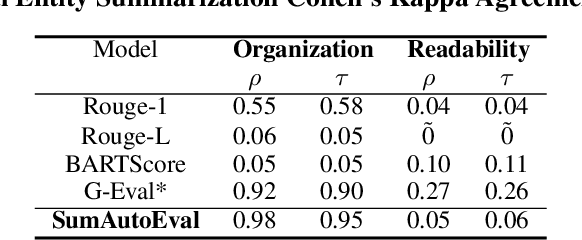

Abstract:Due to the exponential growth of information and the need for efficient information consumption the task of summarization has gained paramount importance. Evaluating summarization accurately and objectively presents significant challenges, particularly when dealing with long and unstructured texts rich in content. Existing methods, such as ROUGE (Lin, 2004) and embedding similarities, often yield scores that have low correlation with human judgements and are also not intuitively understandable, making it difficult to gauge the true quality of the summaries. LLMs can mimic human in giving subjective reviews but subjective scores are hard to interpret and justify. They can be easily manipulated by altering the models and the tones of the prompts. In this paper, we introduce a novel evaluation methodology and tooling designed to address these challenges, providing a more comprehensive, accurate and interpretable assessment of summarization outputs. Our method (SumAutoEval) proposes and evaluates metrics at varying granularity levels, giving objective scores on 4 key dimensions such as completeness, correctness, Alignment and readability. We empirically demonstrate, that SumAutoEval enhances the understanding of output quality with better human correlation.
Biology Instructions: A Dataset and Benchmark for Multi-Omics Sequence Understanding Capability of Large Language Models
Dec 26, 2024Abstract:Large language models have already demonstrated their formidable capabilities in general domains, ushering in a revolutionary transformation. However, exploring and exploiting the extensive knowledge of these models to comprehend multi-omics biology remains underexplored. To fill this research gap, we first introduce Biology-Instructions, the first large-scale multi-omics biological sequences-related instruction-tuning dataset including DNA, RNA, proteins, and multi-molecules, designed to bridge the gap between large language models (LLMs) and complex biological sequences-related tasks. This dataset can enhance the versatility of LLMs by integrating diverse biological sequenced-based prediction tasks with advanced reasoning capabilities, while maintaining conversational fluency. Additionally, we reveal significant performance limitations in even state-of-the-art LLMs on biological sequence-related multi-omics tasks without specialized pre-training and instruction-tuning. We further develop a strong baseline called ChatMultiOmics with a novel three-stage training pipeline, demonstrating the powerful ability to understand biology by using Biology-Instructions. Biology-Instructions and ChatMultiOmics are publicly available and crucial resources for enabling more effective integration of LLMs with multi-omics sequence analysis.
COMET: Benchmark for Comprehensive Biological Multi-omics Evaluation Tasks and Language Models
Dec 13, 2024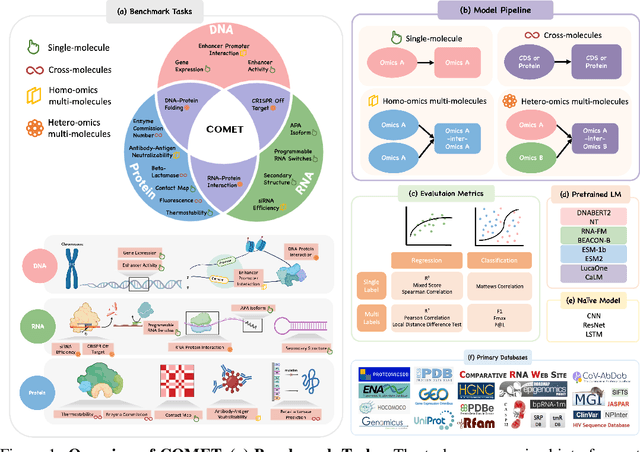
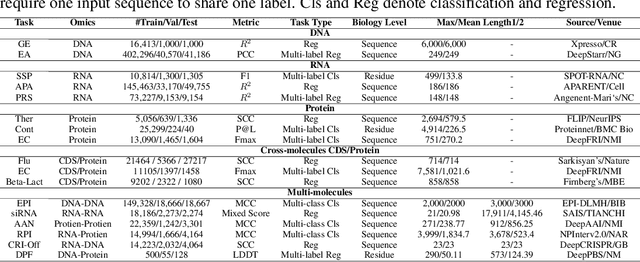

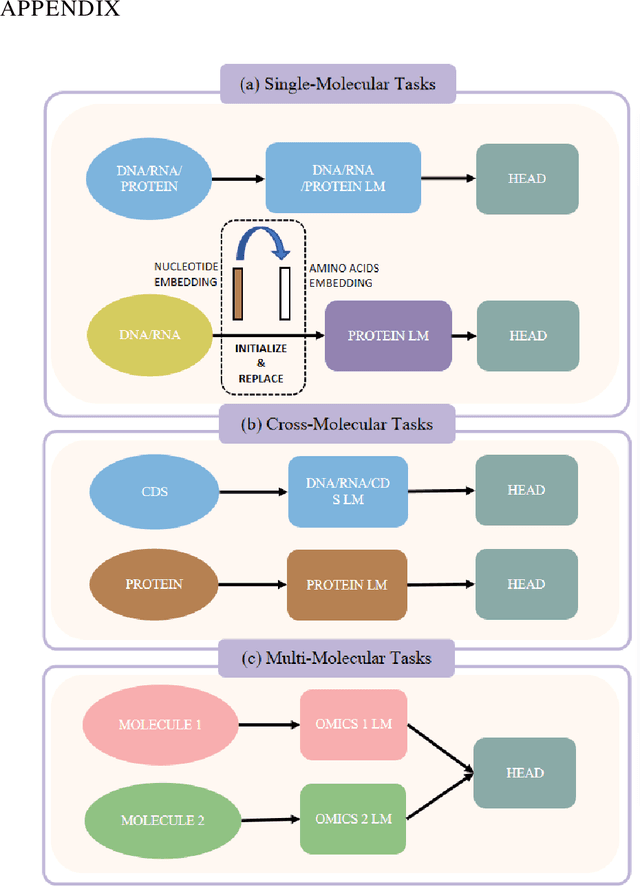
Abstract:As key elements within the central dogma, DNA, RNA, and proteins play crucial roles in maintaining life by guaranteeing accurate genetic expression and implementation. Although research on these molecules has profoundly impacted fields like medicine, agriculture, and industry, the diversity of machine learning approaches-from traditional statistical methods to deep learning models and large language models-poses challenges for researchers in choosing the most suitable models for specific tasks, especially for cross-omics and multi-omics tasks due to the lack of comprehensive benchmarks. To address this, we introduce the first comprehensive multi-omics benchmark COMET (Benchmark for Biological COmprehensive Multi-omics Evaluation Tasks and Language Models), designed to evaluate models across single-omics, cross-omics, and multi-omics tasks. First, we curate and develop a diverse collection of downstream tasks and datasets covering key structural and functional aspects in DNA, RNA, and proteins, including tasks that span multiple omics levels. Then, we evaluate existing foundational language models for DNA, RNA, and proteins, as well as the newly proposed multi-omics method, offering valuable insights into their performance in integrating and analyzing data from different biological modalities. This benchmark aims to define critical issues in multi-omics research and guide future directions, ultimately promoting advancements in understanding biological processes through integrated and different omics data analysis.
CAKD: A Correlation-Aware Knowledge Distillation Framework Based on Decoupling Kullback-Leibler Divergence
Oct 17, 2024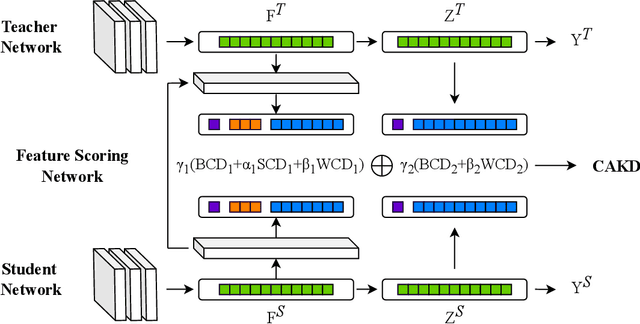


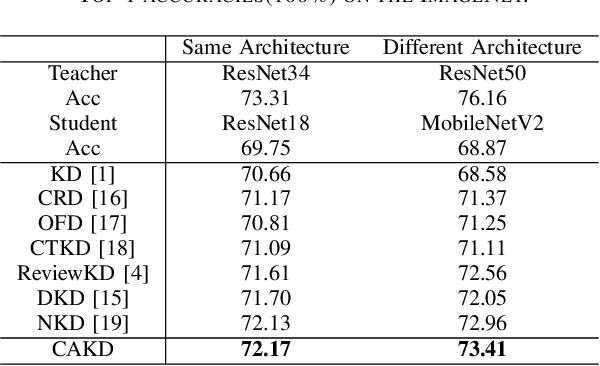
Abstract:In knowledge distillation, a primary focus has been on transforming and balancing multiple distillation components. In this work, we emphasize the importance of thoroughly examining each distillation component, as we observe that not all elements are equally crucial. From this perspective,we decouple the Kullback-Leibler (KL) divergence into three unique elements: Binary Classification Divergence (BCD), Strong Correlation Divergence (SCD), and Weak Correlation Divergence (WCD). Each of these elements presents varying degrees of influence. Leveraging these insights, we present the Correlation-Aware Knowledge Distillation (CAKD) framework. CAKD is designed to prioritize the facets of the distillation components that have the most substantial influence on predictions, thereby optimizing knowledge transfer from teacher to student models. Our experiments demonstrate that adjusting the effect of each element enhances the effectiveness of knowledge transformation. Furthermore, evidence shows that our novel CAKD framework consistently outperforms the baseline across diverse models and datasets. Our work further highlights the importance and effectiveness of closely examining the impact of different parts of distillation process.
Temporal Attention for Cross-View Sequential Image Localization
Aug 28, 2024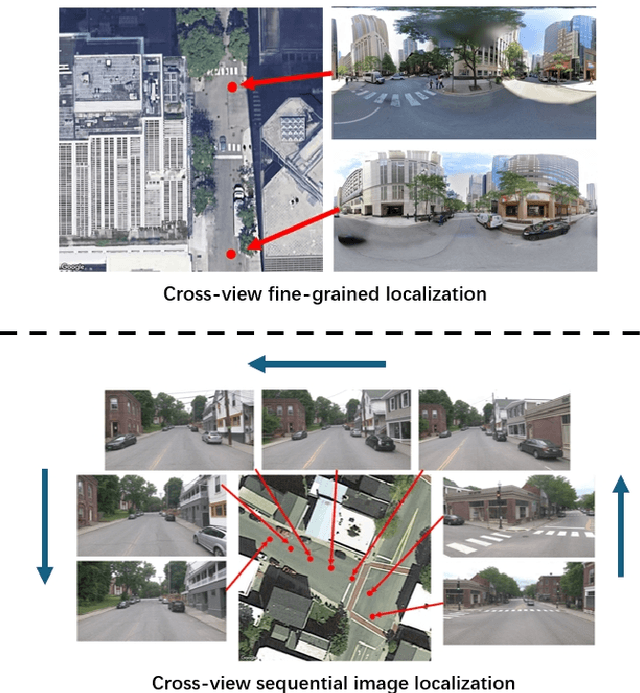
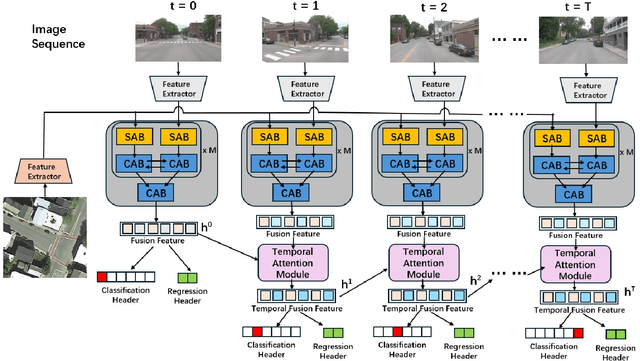
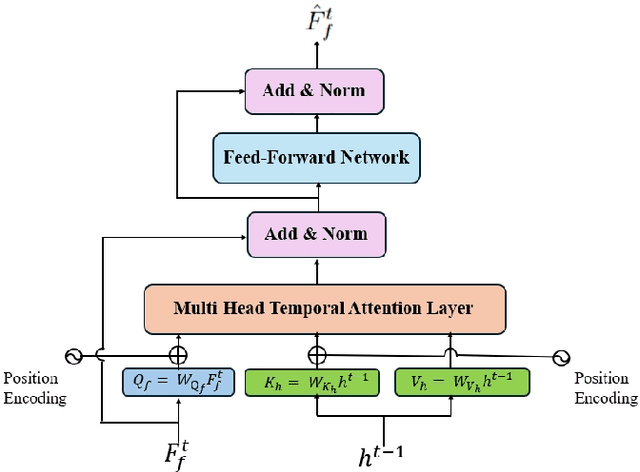
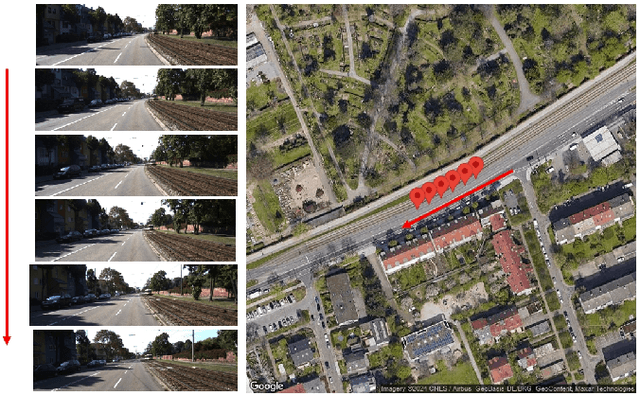
Abstract:This paper introduces a novel approach to enhancing cross-view localization, focusing on the fine-grained, sequential localization of street-view images within a single known satellite image patch, a significant departure from traditional one-to-one image retrieval methods. By expanding to sequential image fine-grained localization, our model, equipped with a novel Temporal Attention Module (TAM), leverages contextual information to significantly improve sequential image localization accuracy. Our method shows substantial reductions in both mean and median localization errors on the Cross-View Image Sequence (CVIS) dataset, outperforming current state-of-the-art single-image localization techniques. Additionally, by adapting the KITTI-CVL dataset into sequential image sets, we not only offer a more realistic dataset for future research but also demonstrate our model's robust generalization capabilities across varying times and areas, evidenced by a 75.3% reduction in mean distance error in cross-view sequential image localization.
Radio Frequency Signal based Human Silhouette Segmentation: A Sequential Diffusion Approach
Jul 27, 2024



Abstract:Radio frequency (RF) signals have been proved to be flexible for human silhouette segmentation (HSS) under complex environments. Existing studies are mainly based on a one-shot approach, which lacks a coherent projection ability from the RF domain. Additionally, the spatio-temporal patterns have not been fully explored for human motion dynamics in HSS. Therefore, we propose a two-stage Sequential Diffusion Model (SDM) to progressively synthesize high-quality segmentation jointly with the considerations on motion dynamics. Cross-view transformation blocks are devised to guide the diffusion model in a multi-scale manner for comprehensively characterizing human related patterns in an individual frame such as directional projection from signal planes. Moreover, spatio-temporal blocks are devised to fine-tune the frame-level model to incorporate spatio-temporal contexts and motion dynamics, enhancing the consistency of the segmentation maps. Comprehensive experiments on a public benchmark -- HIBER demonstrate the state-of-the-art performance of our method with an IoU 0.732. Our code is available at https://github.com/ph-w2000/SDM.
Threats and Defenses in Federated Learning Life Cycle: A Comprehensive Survey and Challenges
Jul 11, 2024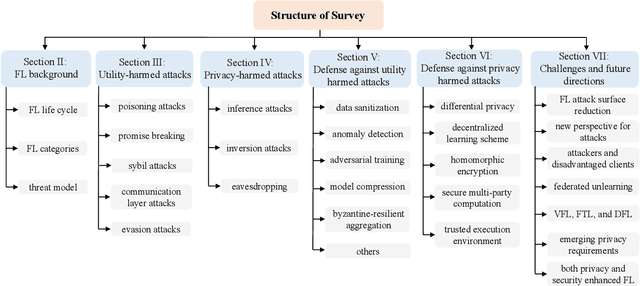
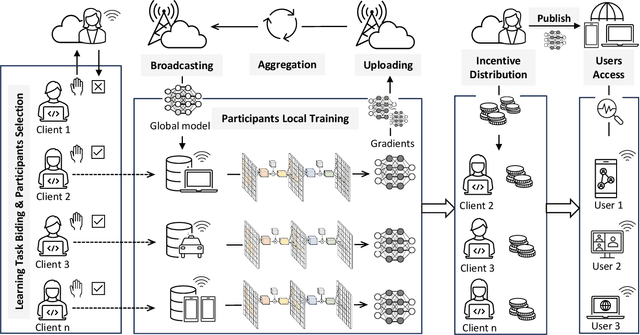
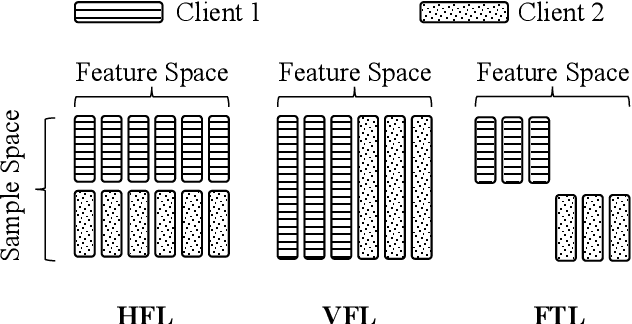
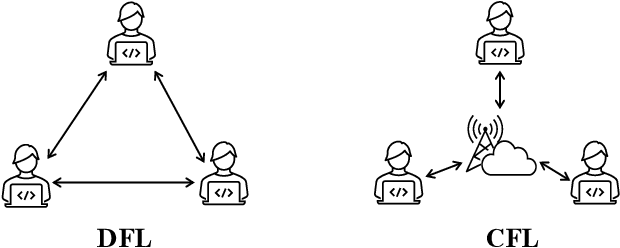
Abstract:Federated Learning (FL) offers innovative solutions for privacy-preserving collaborative machine learning (ML). Despite its promising potential, FL is vulnerable to various attacks due to its distributed nature, affecting the entire life cycle of FL services. These threats can harm the model's utility or compromise participants' privacy, either directly or indirectly. In response, numerous defense frameworks have been proposed, demonstrating effectiveness in specific settings and scenarios. To provide a clear understanding of the current research landscape, this paper reviews the most representative and state-of-the-art threats and defense frameworks throughout the FL service life cycle. We start by identifying FL threats that harm utility and privacy, including those with potential or direct impacts. Then, we dive into the defense frameworks, analyze the relationship between threats and defenses, and compare the trade-offs among different defense strategies. Finally, we summarize current research bottlenecks and offer insights into future research directions to conclude this survey. We hope this survey sheds light on trustworthy FL research and contributes to the FL community.
Fairpriori: Improving Biased Subgroup Discovery for Deep Neural Network Fairness
Jun 25, 2024Abstract:While deep learning has become a core functional module of most software systems, concerns regarding the fairness of ML predictions have emerged as a significant issue that affects prediction results due to discrimination. Intersectional bias, which disproportionately affects members of subgroups, is a prime example of this. For instance, a machine learning model might exhibit bias against darker-skinned women, while not showing bias against individuals with darker skin or women. This problem calls for effective fairness testing before the deployment of such deep learning models in real-world scenarios. However, research into detecting such bias is currently limited compared to research on individual and group fairness. Existing tools to investigate intersectional bias lack important features such as support for multiple fairness metrics, fast and efficient computation, and user-friendly interpretation. This paper introduces Fairpriori, a novel biased subgroup discovery method, which aims to address these limitations. Fairpriori incorporates the frequent itemset generation algorithm to facilitate effective and efficient investigation of intersectional bias by producing fast fairness metric calculations on subgroups of a dataset. Through comparison with the state-of-the-art methods (e.g., Themis, FairFictPlay, and TestSGD) under similar conditions, Fairpriori demonstrates superior effectiveness and efficiency when identifying intersectional bias. Specifically, Fairpriori is easier to use and interpret, supports a wider range of use cases by accommodating multiple fairness metrics, and exhibits higher efficiency in computing fairness metrics. These findings showcase Fairpriori's potential for effectively uncovering subgroups affected by intersectional bias, supported by its open-source tooling at https://anonymous.4open.science/r/Fairpriori-0320.
BEACON: Benchmark for Comprehensive RNA Tasks and Language Models
Jun 14, 2024Abstract:RNA plays a pivotal role in translating genetic instructions into functional outcomes, underscoring its importance in biological processes and disease mechanisms. Despite the emergence of numerous deep learning approaches for RNA, particularly universal RNA language models, there remains a significant lack of standardized benchmarks to assess the effectiveness of these methods. In this study, we introduce the first comprehensive RNA benchmark BEACON (\textbf{BE}nchm\textbf{A}rk for \textbf{CO}mprehensive R\textbf{N}A Task and Language Models). First, BEACON comprises 13 distinct tasks derived from extensive previous work covering structural analysis, functional studies, and engineering applications, enabling a comprehensive assessment of the performance of methods on various RNA understanding tasks. Second, we examine a range of models, including traditional approaches like CNNs, as well as advanced RNA foundation models based on language models, offering valuable insights into the task-specific performances of these models. Third, we investigate the vital RNA language model components from the tokenizer and positional encoding aspects. Notably, our findings emphasize the superiority of single nucleotide tokenization and the effectiveness of Attention with Linear Biases (ALiBi) over traditional positional encoding methods. Based on these insights, a simple yet strong baseline called BEACON-B is proposed, which can achieve outstanding performance with limited data and computational resources. The datasets and source code of our benchmark are available at https://github.com/terry-r123/RNABenchmark.
 Add to Chrome
Add to Chrome Add to Firefox
Add to Firefox Add to Edge
Add to Edge